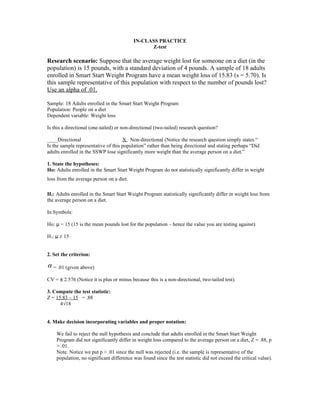
Z Test In Class Practice Problem Key
- 1. IN-CLASS PRACTICE Z-test Research scenario: Suppose that the average weight lost for someone on a diet (in the population) is 15 pounds, with a standard deviation of 4 pounds. A sample of 18 adults enrolled in Smart Start Weight Program have a mean weight loss of 15.83 (s = 5.70). Is this sample representative of this population with respect to the number of pounds lost? Use an alpha of .01. Sample: 18 Adults enrolled in the Smart Start Weight Program Population: People on a diet Dependent variable: Weight loss Is this a directional (one-tailed) or non-directional (two-tailed) research question? ____Directional X Non-directional (Notice the research question simply states “ Is the sample representative of this population” rather than being directional and stating perhaps “Did adults enrolled in the SSWP lose significantly more weight than the average person on a diet.” 1. State the hypotheses: Ho: Adults enrolled in the Smart Start Weight Program do not statistically significantly differ in weight loss from the average person on a diet. H1: Adults enrolled in the Smart Start Weight Program statistically significantly differ in weight loss from the average person on a diet. In Symbols: Ho: μ = 15 (15 is the mean pounds lost for the population – hence the value you are testing against) H1: μ ≠ 15 2. Set the criterion: α = .01 (given above) CV = ± 2.576 (Notice it is plus or minus because this is a non-directional, two-tailed test). 3. Compute the test statistic: Z = 15.83 – 15 = .88 4√18 4. Make decision incorporating variables and proper notation: We fail to reject the null hypothesis and conclude that adults enrolled in the Smart Start Weight Program did not significantly differ in weight loss compared to the average person on a diet, Z = .88, p > .01. Note. Notice we put p > .01 since the null was rejected (i.e. the sample is representative of the population, no significant difference was found since the test statistic did not exceed the critical value).
- 2. 5. Compute the confidence interval CI99 = μ ± Critical value (σ ) √n 15 ± 2.576 (4/ √18) = 15 ± 2.42 [12.58, 17.42] This interval is obtained by taking 15 minus 2.42 and 15 plus 2.42). 6. Interpret the confidence interval: 99% of all possible means for sample sizes of 18 in the population of people on a diet will lose between 12.58 and 17.42 pounds, on average. Notice that the eighteen adults enrolled in the SSWP lost 15.83 pounds, on average and that this value falls in the confidence interval. Hence, this sample was representative of the population. In other words, this sample was not significantly different from the population of dieters with respect to weight loss.